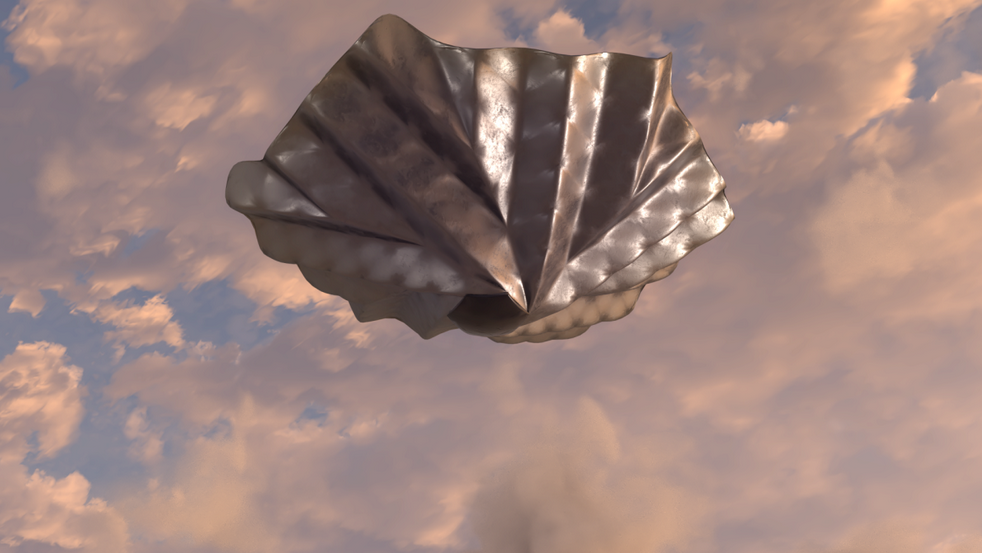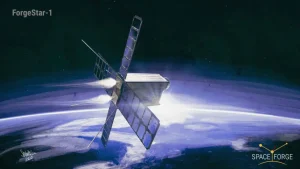Space Forge Pridwen reusable heat shield unveiled
16th May 2023
One of the UK’s most promising small companies, Space Forge, has revealed its new heat shield, dubbed Pridwen. The Wales-based company will soon be the first to launch a reusable satellite manufacturing platform, leveraging the space environment to address challenges on Earth. The in-space manufacturing platform, ForgeStar, will utilize the benefits of zero-gravity for research experiments and production for pharmaceuticals, electronics, and alloys. This heat shield will facilitate the satellite’s safe entry back to Earth.
Further, the company has also created a prototype of a hover net that the platform will land on after re-entering the Earth’s atmosphere. The water vehicle is called Fielder and will transport the space platform to a port after returning from space.
Space Forge Pridwen, the reusable heat shield
The heat shield is an impressive feat for the small company, as other reusable platforms on the market currently use ablative shields, which require replacement every time. But the Pridwen has been developed with high-temperature alloys that are “large enough to radiate the heat of re-entry away without burning the material; making it fully reusable”, the company says.
Heat shields are crucial to protect satellites that return to Earth from space. The re-entry into Earth is hot and fiery, and without a heat shield, satellites will completely burn up. The technology would put Space Forge ahead of the pack when it comes to developing a space product completely reusable, from the satellite platform itself to the re-entry shield.
The shield is extremely large. It covers the entire vehicle after being deployed, but also folds neatly inside the launcher using a “modified origami technique”.
“Our heat shield is a complete rethink of return technology and this concept has never been tried in space before,” said Lead Heat Shield Engineer, Ana Paula Castro de Paula Nunes. “The shield has a unique benefit that its deployed “shuttlecock” shape is large and stable enough to remove the need for a separate parachute and flotation device on the returning Space vehicle; removing two of the key challenges for ablative return vehicles.
“We are confident that Pridwen technology could be expanded to return material from the Moon and Asteroids and could even be used for landing on solar system bodies with an atmosphere, like Mars, Venus or Titan”, she continued.
Although the BBC claimed Space Forge was “coy” when talking about the satellite’s re-entry into Earth previously, in an Orbital Today interview with the company, business development, and marketing officer, Christina MacLeod spoke on the heat shield and its development last November.
Fielder
While the heat shield announcement was expected, Space Forge has also been developing ‘Fielder’ under wraps. The company calls it an “uncrewed high agility water vehicle which manoeuvres itself underneath a re-entry vehicle to soften the landing and enable quick return to a port”.
Astronauts often describe the landing of re-entry vehicles as “like being in a car crash” as the shock levels are so high. Whilst we have shown that many of the key in-space manufactured products such as super alloys and semiconductors can survive such a landing, more fragile items like protein chains used for medicines and research cannot survive without being frozen or glued – which reduces their value.
Our Fielder capture system enables soft landing for re-entry vehicles like the ForgeStar to protect fragile payloads and also reduce stress on the vehicle; reducing the refurbishment cost in a similar manner to the barges used by SpaceX.
Capture System Engineer, Radu Tudorache
Tudorache said he sees the Fielder technology as a “key multiplier” for the future Space to Earth supply chain.
The company built the prototype vehicle with funding from Innovate UK and tested it on a lake in Reading, UK. Space Forge said it has conducted multiple drops of scaled satellite models traveling at terminal velocity to test its “shock levels”.
The technology is also unique in comparison to other satellite or rocket capture technology, like a parachute or controlled landing.
Moving on from Virgin Orbit
In January, Space Forge was one of the industry satellites being carried on the Virgin Orbit aircraft, but the anomaly led to the company’s demonstrator platform, the ForgeStar-0, inevitably being destroyed. However, while the company has moved on from its demonstrator. It is set to launch its ForgeStar-1A satellite from the US later this year, after it gathers “key safety and performance data to enable future landings anywhere in the world”, the company said.
While it is unfortunate that the UK-based company won’t launch from home soil in the near future due to the Virgin Orbit failure, Space Forge continues to prove its resilience as it pioneers unique and world-first technology.







Thank you for your comment! It will be visible on the site after moderation.